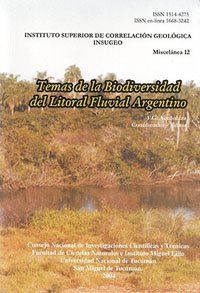Miscelánea 12
Los Mamíferos del Pleistoceno de la Mesdopotamia argentina y su relación con los del Centro Norte de Argentina, Paraguay y Sur de Bolivia y los del Sur de Brasil y Oeste de Uruguay: Paleobiogeografía
Alfredo A. Carlini | A. E. Zurita | G. Gasparini | Jorge I. Noriega
Para adquirir la publicación haga click aquí
Abstract
THE PLEISTOCENE PALAEOMASTOFAUNA FROM THE MESOPOTAMIAN REGION AND ITS RELATIONSHIPS WITH THOSE OF THE MIDDLE-NORTH OF ARGENTINA, PARAGUAY, SOUTHERN BOLIVIA,SOUTHERN BRAZIL AND WESTERN URUGUAY: PALAEOBIOGEOGRAPHY AND PALAEOENVIROMENTS. In this paper we make a taxonomic and palaeobiogeographic comparative analysis of the pleistocene fauna among the following areas: a) eastern of the middle-north of Argentina, Paraguay and southern Bolivia; b) Argentinean Mesopotamia; c) southern Brazil (represented basically by the State of Rio Grande do Sul) and western Uruguay. Paleozoogeographically, we remark an important palaeofaunistic similitude between the areas b and c. This hypothesis is mainly supported by the coexistence of the “pampean” and tropical or intertropical taxa. This suggests, comparing with the Pampean area, more humid and warmer climatic conditions. In the other hand, the palaeofauna founded in b and c are different from a, which shows a high palaeofaunistic similitude with the Pampean region. This resemblance supports a palaeozoogeographic differentiation between the western and eastern sectors of the Paraná river. In this way, it is important to remark that the shared presences in the three areas (a, b and c) of some “pampeans” taxa ( e. g. Toxodon platensis, Glyptodon cf. reticulatus, Megatherium, Stegomastodon platensis, etc.) could be due to migratory processes during the glacial periods, possibly with a south west- north east direction, which would have been facilitated by the decrease of the flow of the Paraná and Uruguay rivers and the migrations of their main beds.




